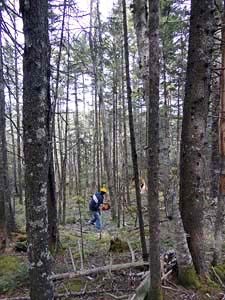On the Theory and Practice of Forestry in Nova Scotia
for the non-forester (like me)
These are some of the resources I have found useful. As well as an interest in conservation and other issues related to forests and forestry, I have a practical interest in managing a small (22ha) piece of land belonging to my family that supports a mature mixed forest. There are clearcuts on either side.
Glossaries
If you didn’t grow up with it, learning about forestry is almost like learning a new language. A glossary can help. ‘Cant access the Canadian Forest Service Glossary anymore.
– Forestry Talk: A Glossary of Common Terms
Ontario Gov., 8 page PDF, with illustrations
– Glossary of Forestry Terms in British Columbia
BC Ministry of Forests and Range 2008. More comprehensive, formal than the Ontario doc above. 130 pages
– Nova Scotia Woodlot Management Home Study: Glossary of Key Terms
Includes terms commonly used in NS, and in the Nova Scotian context
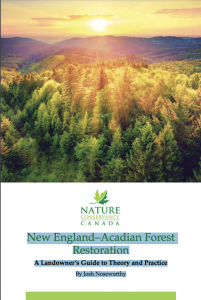 New England–Acadian Forest Restoration: A Landowner’s Guide to Theory and Practice
New England–Acadian Forest Restoration: A Landowner’s Guide to Theory and Practice
By Josh Noseworthy, Nature Conservancy of Canada Publication, available from NSWOOA. “Those who wish to see healthy New England–Acadian Forest can contribute to its restoration using the same forestry practices that have contributed to its decline. As forester and conservationist Aldo Leopold wrote in a 1933 textbook on wildlife management, “The central thesis of [wildlife] management is this: [wildlife] can be restored by the creative use of the same tools which have heretofore destroyed it.” Restoration of the New England–Acadian Forest, with all the species and communities that contribute to our natural heritage, requires using silviculture in creative ways to promote biodiversity…”
NSWOODS.CA Woodland Conferences.
Recorded webinars, many topics, am example:
Fall 2021 Session 1: Pathways to Success- Woodland Stewardship Planning
Wednesday, October 27th, 2021 at 7:00pm
Speaker: Dave Sutherland (Association for Sustainable Forestry)
View recording here. Password: FallSession1
Mike & Debbie Hickey From the Woodlot
Twenty-four Youtube videos (as of May 20, 2020), 6-24 minutes each describing the operation of a family woodlot in N.B. a lot of it with reference to managing for climate change. A very nice intro for people not familiar with forestry practices, these ones smaller scale and ecologically oriented.
Forestry for the Future: Lessons in Sustainable Management from Maine
Video, 26 min. The University of Maine Apr 25, 2020. Highly recommended by NSWOOA
Community Forests International Videos
CFI is based in New Brunswick and conducts work in Atlantic Canada and in Zanzibar, Tanzania. The videos cited below pertain to Atlantic Canada. “What does climate change mean for our forests? Join us as we talk with climate researchers, ecologists, and forestry professionals to understand the projected changes, the associated risks, and how to manage for healthy forest now and into the future.
– Part 1 – Understanding Change (Posted July 13, 2020): examines how the climate is expected to change in the Maritimes and how these changes will affect our unique Wabanaki-Acadian Forest.
– Part 2 – Assessing Your Forest(Posted July 14, 2020): brings us into the forest and explores which tree species and forest types are at risk in a changing climate.
– Part 3 – Managing for the Future< (Posted Jul 17, 2020): we follow forestry professionals as they discuss different climate-smart management for 3 typical forest stand types in our region :
Stand 1: Balsam Fir-Dominated
Stand 2: Mature Mixedwood
Stand 3: Young Mixedwood”
Climate Change Resilience and Carbon Storage Silvicultural Prescriptions for the Acadian Forest Region (PDF of Silvicuture Decision Key); AND Workshop 1 – Presentation of Climate Change Adaptive Silviculture Prescriptions v.1 – Gareth Davies (YOUTUBE VIDEO of presentation, 46 min); also available, a Preview (1 min).
Prepared by Gareth Davies FT, CLP, Forest Ecologist, Silviculturalist with input from Megan de Graaf, MScF, Community Forests International Version 1.0 2019. “The New Brunswick Federation of Woodlot Owners (NBFWO) is working to build the capacity to adapt to changing environmental conditions on private woodlots. This three year project (Fall 2018 – Fall 2021) is supported by funding from Natural Resource Canada’s Climate Change Adaptation Program, GNB’s Environmental Trust Fund, as well as through work by our project partners, Community Forests International, University of New Brunswick and the NB Department of Natural Resources and Energy Development.”
Also view: – Definition of Terms v.1.0
– Appendix B – Supporting Information v.1.0
2019 MFC Capstone Presentations: Jennika Hunsinger
Youtube video. “Effects of forest management on Acadian forest structural diversity and avian species composition in the Medway Community Forest Cooperative license area presented by Jennika Hunsinger on December 11th, 2019” Also view: Effects of forest management on Acadian forest structural diversity and species composition: A baseline biodiversity assessment in the Medway Community Forest Cooperative license area by Jennika E. Hunsinger . A Capstone submitted in conformity with the requirements for the degree of Masters of Forest Conservation Faculty of Forestry University of Toronto
Sustainable Hardwood Management in Today’s Acadian Forest
A conference on best management practices for sustainable forest communities. Held July 8 and 9, 2008 at the Membertou Trade and Convention Centre, Membertou, Cape Breton, Nova Scotia. Presented by the Unama’ki Institute of Natural Resources. Comprehensive document with Q&A, Discussions.
Ecological Forestry: Days 2-4 (Maine Public Lands 1)
On Family Forests (facebook Group). “Maine’s 600,000 acres of public land have been managed for more than 30 years to produce older, larger, and more diverse stands of trees native to the Acadian Forest. Dr. Robert Seymour (in red), professor emeritus of forestry at the University of Maine, has been a member of the silvicultural advisory committee for state-owned woodlands since 1986. Retired forester George Ritz (in green) managed about 80,000 acres of public lands during that same period. In today’s clip, Seymour talks about implementing ecological forestry on Maine’s public lands. William Lahey’s “Independent Review of Forest Practices in Nova Scotia,” released in August 2018, recommended that Nova Scotia also embrace this approach to forest management. Our first question: What is ecological forestry?
A field guide to forest biodiversity stewardship
Peter Neily and Glen J. Parsons. NSDNR 2017. The 126 page guidebook contains a lot of useful information primarily at “the forest stand level”, encourages managers to retain legacy trees, patches of old growth etc. and for some specific situations or wildlife such as as nesting colonies of great blue heron offers very specific instructions on how to protect them. The Eco Notes in each section provide interesting, relevant and practical information about forest biodiversity that will be welcomed all people who have an active interest in our forests regardless of whether they actually manage any forest.
Focus Species Forestry: A Guide to Integrating Timber and Biodiversity Management in Maine
Robert R. Bryan, Maine Audubon, 2007. 98 pp
Silvics of Common Nova Scotia Trees
Appendix 2, page 23 in Spruce – Pine Management Guide by Tim McGrath et al, updated Feb 2017. It gives the ages for maturity (full seed production), over-maturity, info on 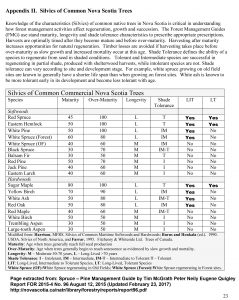 shade tolerance and longevity. “Knowledge of the characteristics (Silvics) of common native trees in Nova Scotia is critical in understanding how forest management activities affect regeneration, growth and succession. The Forest Management Guides (FMG) use stand maturity, longevity and shade tolerance characteristics to prescribe appropriate prescriptions. Harvests are optimally timed after they become mature and before over-maturity. Harvesting after maturity increases opportunities for natural regeneration. Timber losses are avoided if harvesting takes place before over-maturity as slow growth and increased mortality occur at this age.”
shade tolerance and longevity. “Knowledge of the characteristics (Silvics) of common native trees in Nova Scotia is critical in understanding how forest management activities affect regeneration, growth and succession. The Forest Management Guides (FMG) use stand maturity, longevity and shade tolerance characteristics to prescribe appropriate prescriptions. Harvests are optimally timed after they become mature and before over-maturity. Harvesting after maturity increases opportunities for natural regeneration. Timber losses are avoided if harvesting takes place before over-maturity as slow growth and increased mortality occur at this age.”
For convenience, I copied the silvics page and added the age of first seed production: View Silvics + age of first seed production
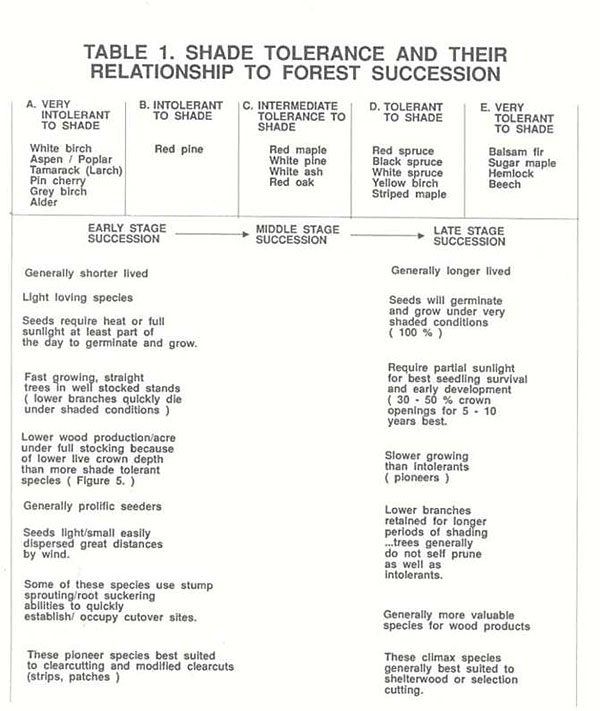
Table 1 in Module 5 of NSDNR Woodlot Management Home Study
“our potentially most valuable trees occupy the middle to late stages of succession”
Strategically Assessing Woodland Health
In University of Kentucky’s Woodlands Magazine, but concisely and well explained and the principles are applicable to our Acadian Forest.
A History of Forestry in Canada
Gilbert Paillé, 44 slides. 2013. Author of book by the same title. View YouTube Interview He describes 5 stages in the evolution of forestry in Canada: commercial forestry-1700’s+, industrial forestry-1800’s+, extensive forestry-1950’s+, multiple-use forestry-1970’s, intensive forestry-2000’s+
Silvicultural Discipline to Maintain Acadian Forest Resilience
by Peter Salonius. 2007. Northern Journal of Applied Forestry 24(2): 91-97. ABSTRACT: “Clearcut harvesting decreases structural complexity, eliminates old and genetically superior legacy trees, extirpates mature-forest floor vegetation, and creates hot and dry postharvest microclimates. The short-lived, exposure-tolerant, boreal tree species that regenerate in large forest openings are believed to be less able, than the late-successional Acadian species they replace, to adapt to the climate warming expected during the next forest rotation. A strip silviculture design is presented that includes limited canopy opening, “no-traffic” areas, maintenance of “full-cycle” survivors, and programmed return harvest intervals that approximate natural gap disturbance as a means of arresting the further increase of boreal species and restoring Acadian species on the landscape. Within the confines of this silvicultural discipline, two management options are described to accommodate extremes of future energy availability.”
Challenges facing gap-based silviculture and possible solutions for mesic northern forests in North America
Christel C. Kern et al. 2017. Forestry 90 (1): 4-17. “Gap-based silvicultural systems were developed under the assumption that richness, and diversity of tree species and other biota positively respond to variation in size of harvest-created canopy gaps. However, varying gap size alone often does not meet diversity objectives and broader goals to address contemporary forest conditions… We pose a revised concept for managers and researchers to use in prescriptions and studies focused on integrated overstory and understory manipulations that increase structural complexity within and around canopy openings.”
Acadian Forest Management and Restoration
Fundy Model Forest, 2008. Slide presentation describes features of the Acadian forest, and management steps appropriate for restoration to something closer to its historical state.
Principles of Ecological Forestry
Chapter 2 by Robert S. Seymour and Malcolm L. Hunter Jr., in Maintaining Biodiversity in Forest Ecosystems, Publisher: Cambridge Univ Press, Editors: M.L. Hunter, pp.22-61
NSDNR self study resources
Woodlot Management – Home Study Program
14 modules. “Choose between studying online, downloading from the site, or mailing in”.
Exceptionally well laid out.
Publications for woodlot owners
These are mostly quick intros, e.g. on tree pruning, crop release. Management of Natural Acadian Forest – A guide to Resources is a 52 page document with active links to related resources.
Leaving a Legacy (Video)
Association for Sustainable Forestry (NS), 2011. “This video [in 3 parts] reviews three forest improvement treatments that promote tree quality and manage for multiple age classes. These treatments include selection management, crop tree pruning, and crop tree release. Selection management is used to create and maintain uneven- aged forest conditions, enhance tree growth, and encourage natural regeneration. Crop tree pruning and crop tree release are used to increase the quality and value of individual trees. This video gives and overview of implementing these treatments from the perspective of various woodlot owners across Nova Scotia.”
Good Forestry in the Granite State
New Hampshire. Available as PDF (227 pages), or as separate chapters in web or PDF form. Comprehensive. Most of it is applicable to Nova Scotia
Integrating Natural Disturbance Parameters into Conventional Silvicultural Systems: Experience From the Acadian Forest of Northeastern North America
Paper by Robert Seymour, 2005, P. 41-48 In: Peterson, C.E. and Maguire, D.A., editors. Balancing ecosystem values: innovating experiments for sustainable forestry. USDA For. Serv. Gen. Tech. Rep. PNW-GTR-635. 389 Available at http://www.fs.fed.us/pnw/publications/gtr635/GTR635a.pdf, text pages 41-48. ABSTRACT: “With rare exceptions, the presettlement Acadian forest of northeastern North America was driven by gap dynamics; true stand replacing disturbances were quite uncommon, with recurrence intervals of many thousands of years. After centuries of human exploitation, stand age structures have become simplified, and commercial timber rotations are a fraction (15 to 40 percent) of the lifespan of the common late-successional tree species. Adapting silvicultural systems to strengthen their ecological foundation thus confronts the challenge of converting single- or two-cohort stands to more complex structures via various combinations of regeneration and retention… A hybrid system is described that combines the proven benefits of shelterwood with the restoration advantages of group selection; in American terminology, the system is an irregular group shelterwood with reserves, similar to the German Femelschlag in which gaps are created and gradually expanded over several cutting cycles.
Also:Silviculture Based on Natural Disturbances: Critical Reflections on Its Status and Future in the Northeastern United States. (View PowerPoint) Invited Keynote for 5th North American Forest Ecology Workshop, Gatineau, Quebec. (Bob Seymour with Alan S. White, 2005.)
Webinars in series Exploring Silvicultural Strategies in Our Changing Forest (Vermont, USA)
– Hemlock and Cedar
– Spruce Fir
– Eastern White Pine
– Northern Hardwoods
Nova Scotia’s Fiery Past: Why early wildfires ignited by our ancestors should not justify modern clearcutting practices
Guest post by Donna Crossland on Medway Community Forest website, Sep. 4, 2015. “The harvest practice of clearcutting more closely mimics a stand-replacement wildfire event (although the effects are not identical), while partial harvests emulate small blow downs or tree mortality caused by insects or diseases. Thus you can see why it is important to accurately define the natural disturbance dynamics that characterize Acadian forests.”
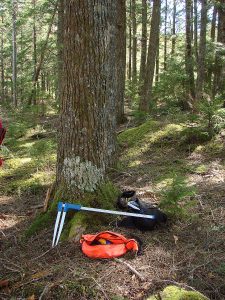
NSWOOA: Acadian Forest Management
“This catalogue of resources is a work in progress. NSWOOA intends for it to become the most comprehensive source of information available on sustainable management of the Acadian Forest.” Resources are listed under the Index of Topics, e.g., the first three are Acadian Forest and General Woodlot Management, Beauty and Solitude, Carbon Storage, Cycling and Offsets.
Also see Management of Natural Acadian Forest. A Guide to resources.
It is bascially a print version of the above.
Guide to FSC Certification for Woodlot Owners in Nova Scotia
Produced by MTRI. The general approaches to management of an Acadian forest promoted by FSC (Forest Stewardship Council) are described. Chs 7,8, 9 provide a lot of natural history and guidelines on how to manage a forest to replicate as much as possible the natural forest. “Specifically, this guide attempts to answer the following questions:
– What is forest certification, and what is the Forest Stewardship Council?/ What benefits can certification offer to woodland owners?/
What does a woodland owner have to do to become certified?/ What are the benefits to joining a group of certified woodland owners?”
See also:
– FSC Certification Standards for Best Forestry Practices in the Maritimes Region and the FSC Certification Standards for Standard for Small and Low Intensity Forests. (January, 2008)
– Government flip-flop on FSC Certification a major step backwards for public forests (EAC, March 1, 2016)
– Going sour (grapes) on FSC certification: NS retaining only less rigorous SFI system on Medway forest Jamie Simpson Sep 16, 2016. He discusses differences between FSC and SFI systems of certification; the former is more rigorous.
– FSC® Certification for Small Woodlot Owners
Nova Scotia Landowners and Forest Fibre Producers Association
– Federation of Nova Scotia Woodland Owners & Mersey Tobeatic Research Institute – FSC Woodlot Certification Program -WOODLOT MANAGEMENT PLAN
The actual template used by woodlot owners for documenting compliance with FSC standards. See related documents at nswoodlots.com
Operational trial of the selection cut using the 123 method In collaboration with NewPage Port Hawkesbury (2011)
“… the 123 method was developed to allow harvesting operations under the concept of a “perpetual forest cover” system. This method meets the uneven-aged management regime requirements because it permits the three basic silvicultural functions—harvesting, tending, and regenerating—in one operation. Application of the selection cut in softwood forests using the 123 method developed by FPInnovations addressed wildlife habitat concerns, maintained visual quality of highly valued landscape, and provided alternatives in ecosystem-based management schemes… [In this study] A stand mainly composed of sugar maple, located in nearby Heatherton, Nova Scotia, was selected as a replacement for a group selection cut… The trial results show that the selection cut using the 123 method can be used to manage hardwood forests.” Another trial was conducted in 2013: Operational trial of the Selection cut using the “123” method at Northern Pulp Nova Scotia Corporation, with seemingly promising results. Curiously or at least regrettably, the report(s) by FPInnovations on application of the 123 method to softwood forests seems to be no longer available.
———————————————-
Riparian Zone
Proceedings of the Symposium on RIPARIAN ZONE MANAGEMENT
Canadian Forest Service – Maritimes Region. 1994. Lots of still relevant content: The Role Of The Riparian Zone As It Affects Water Quality, Riparian Zone Considerations for Management of Fish, Fish Habitat, And Sport Fishing In New Brunswick, The Importance of Riparian Zones as Wildlife Habitat, The Role of the Riparian Zone as it Relates to Recreational Activities Riparian Zone Management: Legislation and Objectives, Oregon’s Forest Practices Act and Riparian Rules, “In-Stream” Management Techniques to Enhance Fish Habitat, Managing Riparian Habitat for Songbirds, Raptors and Small Mammals, The “Puddle-Jumping” Model of Sediment Movement Through Riparian Strips, Softwood Management Techniques in the Riparian Zone, Silviculture Recommendations for Riparian Zones on Prince Edward Island, Recreation in the Riparian Zone: Practical Advice for Forest Managers, Symposium Summary.
An Ecological Approach to Riparian-Buffer Definition, and Implications for Timber Harvests in Nova Scotia, Canada
Patricia Stoffyn-Egli1 & Peter N. Duinker 2013. In Journal of Sustainable Development; Vol. 6, No. 12; 2013
A study was conducted in the The Upper Mersey River (UMR) watershed to examine implications of a 50 m riparian buffer (NS requires only 20). “The delineation method has been applied using spatial analysis to a watershed in Nova Scotia, Canada. A 50-m buffer represents 15% of the watershed terrestrial area. Excluding timber harvest in this buffer decreases the total potential harvestable volume by 11% compared to provincial regulations and by 7% compared to the practices of the local forest-products company. The simplicity of the proposed riparian buffer delineation lends itself to easy implementation by any landowner with little training and cost, a distinct advantage considering the urgency of protecting freshwater ecosystems. Moreover, continuous buffers can serve as wildlife movement corridors throughout the watershed and are thus an essential component of connectivity planning at the landscape scale.”
Also see Setbacks & Vegetated Buffers in Nova Scotia:A review and analysis of current practices and management options by Emily Rideout, 2012.
Pockwock – Bowater Watershed Study: Wind Damage in Streamside Management Zones
Daralyn McCurdy and Bruce Stewart, NSDNR. 2008. “The highest concentration of blowdown and soil exposure occurred along the clearcut edge where the trees were most exposed. In all cases blowdown and soil exposure levels declined as distance from the cut edges increased, except in the 1 m strip along the stream edges. Blowdown and soil exposure next to the stream was highest in the 20m thinned SMZ’s. Although there was more blowdown and soil exposure recorded for the 30 m thinned watersheds compared to the 20 m unthinned watersheds (average), there was less blowdown and soil exposure in the 10 m strip next to the stream in the 30 m thinned watersheds, suggesting that the penetrating effect of the wind was reduced, thereby lessening wind throw. Blowdown damage near the stream in the 30 m thinned watershed was very light, and similar to the untreated control watersheds. To maintain the highest integrity of stream side forest after a harvest, these early results suggest that the use of a 30 m SMZ is favourable in these conditions.”
Providing More Acadian Forest Wildlife Habitats in Today’s Managed Forests
Referenced article by Bob Bancroft.~2009. “There is a need to incorporate more missing features of original Acadian forests into today’s managed forest landscapes. Many of these features can be located in riparian zones, which are lands beside waterways that have a disproportionately high amount of use by wildlife. Riparian zones are a potential means to connect the landscape for wildlife.”
———————————————-
Silvicultural alternatives to conventional even-aged forest management – what limits global adoption?
Klaus J Puettmann et al. in Forest Ecosystems 9 April 2015
A silvicultural and economic comparison of clearcutting and partial cutting studies in northeastern North America
by Caitlyn Chappell and Jamie Simpson, 2010. EAC document. “We reviewed and synthesized information sources that examine yield, regeneration, stand composition, costs, revenue and employment generated by clearcutting and partial cutting systems in the Acadian and other forest types in north-eastern North America with the aim of informing an analysis of the potential impacts of reducing the prevalence of clearcutting in Nova Scotia.”
Implementing Complex Partial Harvests in Central Maine: Is Tree Marking Necessary?
Sam Grimm, University of Maine MS thesis, 2015 Advisor: Robert S. Seymour. “In northeastern North America, tree marking — the simple designation of cut or leave trees to implement a given silvicultural prescription — has declined, in favor of reliance on machine operators to implement written or verbal prescriptions. This study is among the first to explore the costs and benefits of tree-marking in complex mixed-species stands typical of the Acadian region.”
Tree Marking – why not in Nova Scotia?
Post on this website, Nov 10, 2016.
Mechanized Forestry
Timber Harvesting Systems (New Hampshire)
Lumber and Forestry
Automation in Forestry – Development of Unmanned Forwarders
Canadian Forestry Operations in the Next Century
Technology Improvement in Logging
Feller Buncher
Felling
Mechanized logging (video)
Timber Harvesting: Part 1 (logging)
Tigercat TH575 mixed stand in Nova Scotia
NSDNR Home Study Module Lesson 3 The Selection System
describes use of heavy equipment in a selection cut.
See also: Module 12: Small Scale Harvesting Equipment – What’s Right For You?
The right stuff all the way ’round
Article in Logging and Sawmilling Journal by George Fuullerton, Oct 2017. “Nova Scotia logger Peter Archibald understands full well that he needs the right gear to deliver the right wood to the right mill, and he now has some new equipment—and some newly-trained operators—to deliver that wood.”
Mean Annual Increment, Periodic Annual Increment, Site Index Etc
See section on Forest Mensuration
Last Log Drive on the Clyde River (1940s)
Youtube Video, NS Archives. How the forests and forestry have changed!
Timber Management: Which Trees To Cut and Why
West Virginia Public Broadcasting, June 28, 2017. For West Virginia but good explanation of some of the principles.
A Damaging Tradition: Diameter-Limit Cutting Diminishes a Woodlot
by Irwin Post in Northern Woodlands, Autumn 2008.
Using historic soil survey data to map water erosion hazard for land-use planning in Nova Scotia
Kevin keys et al., 2015 Canadian Journal of Soil Science 95(3):299-304 ” Results showed approximately 62% of Nova Scotia has low erosion hazard, 33% has moderate hazard, and 5% has high hazard. The erosion hazard map was subsequently used in a provincial watershed assessment program (NSWAP) to map potential water quality stressors related to land-use patterns on erodible soils.”
Foresters and ecologists see forests differently
GEORGE WUERTHNER George Wuertner in the Independent Recordm Apr 3, 2018. Insightful.
Dimensions of Power in Forest Resource Decision-Making: A Case Study of Nova Scotia’s Forest Conservation Legislation
PhD thesis by Glyn Charles Bissix, The London School of Economics and Political Science University of London 1999. Appendix B, page 277-282 provides a Chronology of Nova Scotia Forestry, 1755 to 1998.
FOREST LAND BEST MANAGEMENT PRACTICES in the Finger Lakes Region of New York State
Well ilustrated
Forest Roads: A Synthesis of Scientific Information
Hermann Gucinski et al. 2001 . USDA Forest Service, Pacific Northwest Research Station, General Technical Report PNW-GTR-509 May 2001. 120 pages. Abstract: Effects of roads in forested ecosystems span direct physical and ecological ones (such
as geomorphic and hydrologic effects), indirect and landscape level ones (such as
effects on aquatic habitat, terrestrial vertebrates, and biodiversity conservation), and
socioeconomic ones (such as passive-use value, economic effects on development
and range management). Road effects take place in the contexts of environmental
settings, their history, and the state of engineering practices, and must be evaluated in
those contexts for best management approaches.
Danny George on getting value from your wood 3 videos by Paul Bissonnette
“The release of Peter Murphy’s and ACALA’s video “It’s TOO Big – Biomass” was designed to be a stark one sided look at the Point Tupper Biomass Plant. There was need to shock the public into realizing what was happening in Nova Scotia the forest industry.
“While operating a camera for this video. One of the comment that stuck in my mind was a statement from Danny George: If the logging industry (as it is now) was to shutdown it would be the best thing to happen. A value on industry would slowly evolve.
“After it’s was released I received permission to edit my version based around Danny George’s comment. Danny’s 40+ years of experience in the logging industry was used to show how to take as much value out of the logs as possible before shipping the unusable rest to the Biomass plant. The three trees in the videos would have have very little value as the price at that time was around $49 a ton delivered. Harvesting them only for Biomass with out proper knowledge how to abtain the most value value is simple throwing hundreds of dollars out the window. Simply stated burning gold.
“I uploaded 3 short clips called Burning Gold episode 1 – 3 to My Vimeo account “BlindMouseMedia”
Episode 1
https://vimeo.com/185412269
Episode 2
https://vimeo.com/232408490
Episode 3
https://vimeo.com/232976364”
SELECTION CUTTING IN RED SPRUCE A Comparison of Methods Establishment Report
Bruce Stewart et al., 2009. NSDNR. “The goal of this research is to develop a scientific understanding of forest response to selection cutting that will lead to effective selection management techniques and guidelines. It is designed to study treatment effects on growth and yield, tree quality, regeneration, age class structure, blowdown, and a range of ecological parameters including coarse woody debris, structural diversity, plant species diversity and dynamics of large retained legacy trees. The trial has a longterm outlook (75+ years) that will include periodic treatments and regular measurement cycles. It will involve management manipulations targeting basal area retention, light availability, species selection, and quality improvement.
Growth of forests in Canada. Part 2: A quatitative description of the Land Base and mean Annual Increment
A. Bickerson et al., 1981. Environment Canada Forestry Service
Meeting our Mentors
On www.medwaycommunityforest.com, July 25, 2019. Bob Seymour meets with MCFC
Stump-Grown Christmas Trees Are the Gift That Keeps on Giving
By Alla Katsnelson On Smithsonian.com Using the sustainable and ancient method of coppicing, evergreen Christmas trees can be regrown indefinitely
Penobscot Experimental Forest Research Highlights
“This video highlights silvicultural research on the Penobscot Experimental Forest, focusing on shelterwood, single-tree selection, diameter limit cutting, exploitive harvest, and ecological forestry. The video was produced through a partnership with the University of Maine.”Potsed on YouTube Mar 3, 2020
Homogenization of the terrestrial water cycle
Delphis F. Levia et al., 2020. Nature Geoscience 21 Sep 2020. “Land-use and land-cover changes are accelerating. Such changes can homogenize the water cycle and undermine planetary resilience. Policymakers and practitioners must consider water–vegetation interactions in their land-management decisions… the global coverage of forest plantations increased from 167.5 million ha in 1990 to 277.9 million ha by 2015… These land conversions are changing water demand: forest plantations with fast-growing, short-rotation species are likely to use more water compared to indigenous vegetation and older plantations…Both deforestation and reforestation efforts seldom consider the consequences for the resilience of the water cycle to stressors…Current global trends in land-use change towards monocultures are risking a more homogeneous terrestrial water cycle with consequences for planetary resilience. Policymakers and practitioners should design forests and agricultural systems that embrace the differences among plant species to maintain the variation in the hydrological response of the land surface in both rural and urban areas. By recognizing, preserving or enhancing the nature-based resilience inherent in the diverse array of hydrological responses among plant species, we can provide better stewardship of the Earth’s finite water resources.”
A Selection Management Operation
Healthy Forest Coalition
Effects of forest management on Acadian forest structural diversity and species composition A baseline biodiversity assessment in the Medway Community Forest Cooperative license area by Jennika E. Hunsinger 2020. “A Capstone submitted in conformity with the requirements for the degree of Masters of Forest Conservation Faculty of Forestry University of Toronto”
Mini-rotation Forestry
EJ Schreiner, U.S.D.A. FOREST SERVICE RESEARCH PAPER NE-174 1970 NORTHEASTERN FOREST EXPERIMENT STATION, UPPER DARBY, PA. Informative 32 page document relevant to the Northeast of the USA. Rotaions times etc. Predictions about future trends.

